Most North American Ospreys (Pandion haliaetus) are migratory, breeding in northern latitudes and migrating long distances to and from their wintering grounds in the tropics. Although fall migration patterns of North American Ospreys have been described and studied, very little has been published about the spring migration of these birds. We used satellite telemetry to: (1) determine the characteristics (timing, duration, migratory routes) of spring migrations of Ospreys; (2) determine if differences in spring migration patterns existed between sexes and among three breeding populations (east coast, midwestern, and western); and (3) compare consecutive fall and spring migrations of individual Ospreys. The median dates for departure from the wintering grounds and arrival on the breeding grounds did not differ significantly between adult male and female Ospreys. Compared to their fall migrations, all male and all east coast Ospreys spent fewer days on migration, fewer days in stopover periods along the migration route, traveled shorter distances overall, and traveled farther (on average) each day during spring. In contrast, fall and spring migration characteristics of all female and western Ospreys were similar. Our findings suggest that, although sex and breeding location might influence the spring migration strategy used by individual Ospreys, both males and females minimize the time spent on migration to ensure a timely arrival on the breeding grounds to establish or defend a nesting territory.
La mayoría de los individuos de Pandion haliaetus son migratorios, reproduciéndose en latitudes hacia el norte y migrando largas distancias hacia y desde los sitios de invernada en los trópicos. Aunque los patrones de migración otoñal de P. haliaetus han sido descriptos y estudiados, se ha publicado muy poco sobre la migración primaveral de esta especie. Utilizamos telemetría satelital para: (1) determinar las características (tiempos, duración, rutas migratorias) de la migración primaveral de P. haliaetus; (2) determinar si las diferencias en los patrones de migración primaveral existieron entre sexos y entre tres poblaciones reproductivas (costa este, medio oeste y oeste); y (3) comparar migraciones consecutivas de otoño y primavera de individuos de P. haliaetus. Las fechas medianas de partida desde los sitios de invernada y de arribo a los sitios de reproducción no difirió significativamente entre individuos macho y hembra de P. haliaetus. En comparación con las migraciones otoñales, todos los individuos de P. haliaetus macho y todos los individuos de la costa este emplearon menos días migrando, menos días en periodos de descanso a lo largo de la ruta de migración, viajaron distancias más cortas en general y viajaron más lejos (en promedio) cada día durante la primavera. En contraste, las características migratorias de otoño y primavera de todos los individuos hembra y macho de P. haliaetus fueron similares. Estos hallazgos sugieren que aunque el sexo y la ubicación del sitio de reproducción pueden influir en la estrategia de migración primaveral utilizada por los individuos de P. haliaetus, tanto hembras como machos minimizan el tiempo empleado en la migración para asegurarse un arribo a tiempo a los sitios de reproducción para establecer o defender un territorio de nidada.





